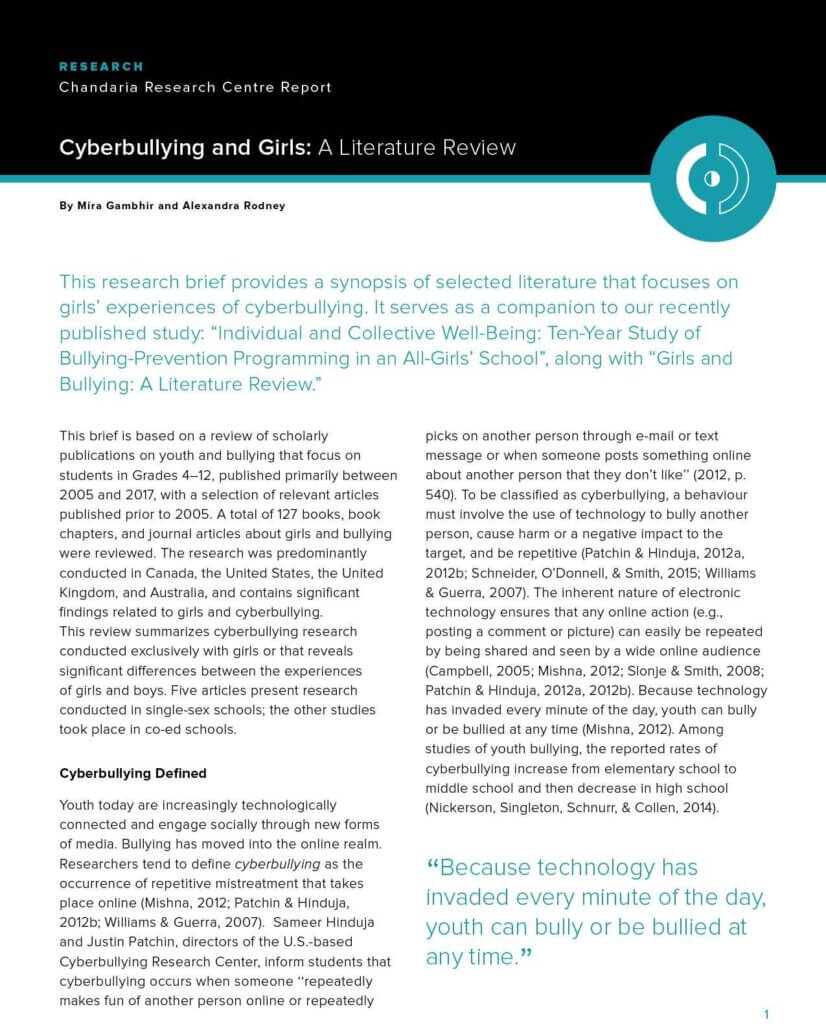Beran, T.N., & Li, Q. (2007). The relationshipbetween cyber-bullying and school bullying. Journal of Student Wellbeing, 1(2), 16–33.
Betts, L.R., Spenser, K.A., & Gardiner, S.E. (2017). Adolescents’ involvement in cyber bullying and perceptions of school: The importance of perceived peer acceptance for female adolescents. Sex Roles, 77(7–8), 471–481.
Boak, A., Hamilton, H.A., Adlaf, E.M., Henderson, J.L., & Mann, R.E. (2015). The mental health and wellbeing of Ontario students 1991–2015: Detailed OHDUHS findings. CAMH Research Document Series No. 43. Toronto, ON: Centre for Addiction and Mental Health.
Burgess-Proctor, A., Patchin, J.W., & Hinduja, S. (2010). Cyberbullying and online harassment: Reconceptualizing the victimization of adolescent girls. In V. Garcia and J. Clifford (Eds.), Female crime victims: Reality reconsidered (pp. 162–176). Upper Saddle River, NJ: Prentice Hall.
Campbell, M.A. (2005). Cyber bullying: An old problem in a new guise? Australian Journal of Guidance & Counselling, 15(1), 68–76.
Cappadocia, M., Craig, W., & Pepler, D. (2013). Cyberbullying: Prevalence, stability, and risk factors during adolescence. Canadian Journal of School Psychology, 28(2), 171–192.
Cassidy, W., Jackson, M., & Brown, K.N. (2009). Sticks and stones can break my bones, but how can pixels hurt me? Students’ experiences with cyber-bullying. School Psychology International, 30(4), 383–402.
Crooks, H.R. (2016). An intersectional feminist review of the literature on gendered cyberbullying: Digital girls. Jeunesse: Young People, Text, Culture, 8(2), 62–88.
Festl, R., & Quandt, T. (2016). The role of online communication in long-term cyberbullying involvement among girls and boys. Journal of Youth and Adolescence, 45(9), 1931–1945.
Floros, G.D., Simos, K.E., Fisoun, V., Dafouli, E., & Geroukalis, D. (2013). Adolescent online cyberbullying in Greece: The impact of parental online security practices, bonding, and online impulsiveness. Journal of School Health, 83(6), 445–453.
Heiman, T., & Olenik-Shemesh, D. (2015). Cyberbullying experience and gender differences among adolescents in different educational settings. Journal of Learning Disabilities, 48(2), 146–155.
Hinduja, S., & Patchin, J.W. (2015). Bullying beyond the schoolyard: Preventing and responding to cyberbullying (2nd ed.). Thousand Oaks, CA: SAGE Publications.
Hinduja, S., & Patchin, J.W. (2013). Social influences on cyberbullying behaviors among middle and high school students. Journal of Youth and Adolescence, 42(5), 711–722.
Hinduja, S., & Patchin, J.W. (2012). Cyberbullying: Neither an epidemic nor a rarity. European Journal of Developmental Psychology, 9(5), 539–543.
Hinduja, S., & Patchin, J.W. (2009). Bullying beyond the schoolyard: Preventing and responding to cyberbullying. Thousand Oaks, CA: Sage Publications.
Hinduja, S., & Patchin, J.W. (2008). Cyberbullying: An exploratory analysis of factors related to offending and victimization. Deviant Behavior, 29(2), 129–156.
Holfeld, B., & Leadbeater, B. (2015). The nature and frequency of cyber bullying behaviors and victimization experiences in young Canadian children. Canadian Journal of School Psychology, 30(2), 115–35.
Jones, L.M., Mitchell, K.J., & Finkelhor, D. ( 2013). Online harassment in context: Trends from three youth internet safety surveys (2000, 2005, 2010). Psychology of Violence, 3(1), 53–69.
Jackson, M., Cassidy, W., & Brown, K. (2009). “You were born ugly and you’ll die ugly too”: Cyberbullying as relational aggression. In Education, 15(2), 68–82.
Kowalski, R.M., & Limber, S.P. (2007). Electronic bullying among middle school students. Journal of Adolescent Health, 41(6 suppl. 1), S22–S30.
Kowalski, R.M., Limber, S.P., & Agaston, P.W. (2008). Cyber bullying: Bullying in the digital age. Malden, MA: Wiley-Blackwell.
Landstedt, E., & Persson, S. (2014). Bullying, cyberbullying, and mental health in young people. Scandinavian Journal of Public Health, 42(4), 393–399.
Lapidot-Lefler, N., & Dolev-Cohen, M. (2015). Comparing cyberbullying and school bullying among school students: Prevalence, gender, and grade level differences. Social Psychology of Education, 18(1), 1–16.
Li, Q. (2006). Cyberbullying in schools: A research of gender differences. School Psychology International, 27(2), 157–170.
Li, Q. (2007). New bottle but old wine: A research of cyberbullying in schools. Computers in Human Behavior 23, 1777–1791.
Mishna, F. (2012). Bullying: A guide to research, intervention and prevention. Oxford University Press.
Nickerson, A.B., Singleton, D., Schnurr, B., & Collen, M.H. (2014). Perceptions of school climate as a function of bullying involvement. Journal of Applied School Psychology, 30(2), 157–181.
Nordahl, J., Beran, T.N., & Dittrick, C. J. (2013). Psychological impact of cyber-bullying: Implications for school counsellors. Canadian Journal of Counselling and Psychotherapy/Revue canadienne de counseling et de psychothérapie, 47(3), 383-402.
Patchin, J.W., & Hinduja, S. (2010). Cyberbullying and self-esteem. Journal of School Health, 80(12), 614–621.
Patchin, J.W.,& Hinduja, S. (2012a). Cyberbullying: An update and synthesis of the research. In J.W. Patchin and S. Hinduja (Eds.), Cyberbullying prevention and response: Expert perspectives (pp. 13–35). New York: Routledge.
Patchin, J.W., & Hinduja, S. (2012b). Cyberbullying prevention and response: Expert perspectives. New York: Routledge
Patchin, J.W., & Hinduja, S. (2012c). School-based efforts to prevent cyberbullying. The Prevention Researcher, 19(3), 7–9.
Rice, E., & Petering, R., Rhoades, H., Winetrobe, H., Goldbach, J., Plant, A., Montoya, J., & Kordic, T. (2015). Cyberbullying perpetration and victimization among middle-school students. American Journal of Public Health, 105(3), 66–72.
Schneider, S.K., O’Donnell, L, Stueve, A., & Coulter, R.W.S. (2012). Cyberbullying, school bullying, and psychological distress: A regional census of high school students. American Journal of Public Health, 102(1), 171–177.
Schneider, S.K., O’Donnell, L., & Smith, E. (2015). Trends in cyberbullying and school bullying victimization in a regional census of high school students, 2006–2012. Journal of School Health, 85(9), 611–620.
Slonje, R., & Smith, P.K. (2008). Cyberbullying: Another main type of bullying? Scandinavian Journal of Psychology, 49(2), 147–154.
Smith, P., Mahdavi, J., Carvalho, M., & Tippett, N. (2006). An investigation into cyber bullying, its forms, awareness and impact, and the relationship between age and gender in cyber bullying. A report to the Anti-Bullying Alliance. Research Brief No. RBX03-06. London: DfES.
Statistics Canada. (2017). Women in Canada: A Gender-Based Statistical Report –The Girl Child. Ottawa, ON: Ministry of Industry. Catalogue no. 89-503-X
Tarablus, T., Heiman, T., & Olenik-Shemesh, D. (2015). Cyber bullying among teenagers in Israel: An examination of cyber bullying, traditional bullying, and socioemotional functioning. Journal of Aggression, Maltreatment & Trauma, 24(6), 707–720.
Tanrikulu, I., & Campbell, M. (2015). Correlates of traditional bullying and cyberbullying perpetration among Australian students. Children and Youth Services Review, 55, 138–146.
Wade, A., & Beran, T. (2011). Cyberbullying: The new era of bullying. Canadian Journal of School Psychology 26(1), 44–61.
Wang J., Iannotti R.J., & Nansel, T.R. (2009). School bullying among adolescents in the United States: Physical, verbal, relational, and cyber. Journal of Adolescent Health, 45(4), 368–375.
Williams, K.R., & Guerra, N.G. (2007). Prevalence and predictors of Internet bullying. Journal of Adolescent Health, 41(6 suppl 1), S14–S21.
Ybarra, M.L., & Mitchell, K.J. (2004). Youth engaging in online harassment: associations with caregiver-child relationships, Internet use, and personal characteristics. Journal of Adolescence, 27(3), 319–336.
Zych, I., Ortega-Ruiz, R., & Del Rey, R. (2015). Systematic review of theoretical studies on bullying and cyberbullying: Facts, knowledge, prevention, and intervention. Aggression and Violent Behavior, 23, 1–21.








